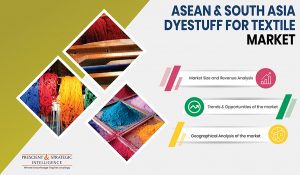In 2014, the Indian government announced plans to set up integrated textile parks and offer financial support to small and mid-size textile companies. In the same way, Indonesia plans to generate $75 billion from textile exports by 2030 and increase its share in the worldwide textile exports by 5%. Such moves are expected to give a massive boost to the textile industry, which would lead to a rapid rise in the demand for various raw materials used here, including yarn and dyestuff.

ASEAN & South Asia Dyestuff for Textile Market
Currently, the demand for these materials in South Asian and Association of Southeast Asian Nations (ASEAN) member countries is rising on account of the growth in the apparel popularity. With an increase in the disposable income and influence of the Western culture, sales of jeans, outerwear, innerwear, T-shirts, dresses, shorts, children’s wear, trousers, and socks are surging in South and Southeast Asian nations. Moreover, these nations are witnessing rapid population growth, which is another reason behind the increasing demand for textiles and, in turn, dyestuff.
The type segment of the ASEAN and South Asian dyestuff for textile market is divided into disperse dyes, reactive dyes, vat dyes, reactive dyes, acid dyes, direct dyes, sulphur dyes, and others, which includes solvent and basic dyes. Among these, during the historical period (2013–2016), the reactive dyes division dominated the market as such dyes bond covalently with cellulose, which is contained in cotton fabric. This makes reactive dyes the most permanent of all types of dyes, which prevents the color from fading quickly.
To receive free sample pages of this report@ https://www.psmarketresearch.com/market-analysis/asean-and-south-asia-dyestuff-for-textile-market/report-sample
Apart from reactive dyes, the demand for natural dyes is also increasing in the textile industry of South Asian and ASEAN countries. Synthetic dyes often contain volatile organic compounds (VOCs), which not only harm the environment but also cause deadly human diseases, such as cancer. This is why dyes made from plants, animal secretions, insects, fruits, and minerals are rapidly becoming popular. These are biodegradable, offer a smooth finish to fabrics, protect the wearer against ultraviolet (UV) radiation, and possess antimicrobial and anti-inflammatory properties.
Similarly, ASEAN and South Asian countries are witnessing a high-volume consumption of dyes that can be applied without water. Just 1 kg of dyestuff requires up to 150 liters of water, which is already scarce in South Asian and ASEAN nations. Moreover, after the dye is mixed in, the water becomes riddled with all sorts of chemicals, which renders it unfit for human consumption. Moreover, by using waterless dyes and dying techniques, textile companies can reduce their effluent and water treatment expenditure by up to 50%.
Till now, the largest country in the ASEAN and South Asian dyestuff for textile market has been India. Due to the closure of dyestuff production plants in several developed countries for failing to comply with the strict environmental norms, the supply of this material has declined, thereby raising its prices. This has opened a door of opportunity for Indian dyestuff manufacturers, who have answered the rising demand and short supply of dyestuff around the world by increasing their own manufacturing capacity for this material.
Get More Details ASEAN & South Asia Dyestuff for Textile Market Impact Of Domestic and Global Market Players
